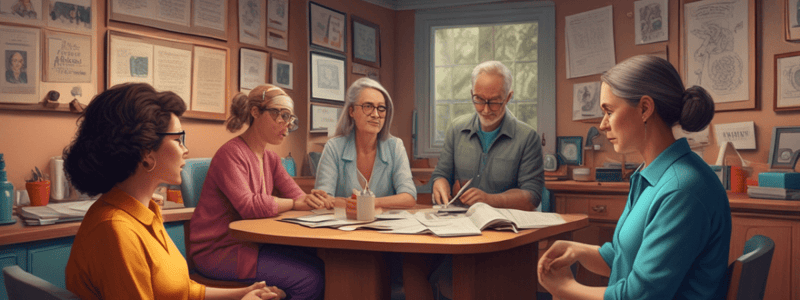Podcast
Questions and Answers
Who is considered the founder of the ecology of human performance?
Who is considered the founder of the ecology of human performance?
- Dunn
- Freud
- Jung
- Erickson (correct)
Which theorist proposed the self-regulatory system model?
Which theorist proposed the self-regulatory system model?
- Jung
- Barton
- Freud
- Bandura (correct)
Which individuals were pioneers of the reconstruction movement after World War I?
Which individuals were pioneers of the reconstruction movement after World War I?
- Dunton and Mary Reily
- Barton and Susan Cox Johnson (correct)
- Erickson and Freud
- Meyer and Jean Ayres
Who were the founders of biomechanical approaches in occupational therapy?
Who were the founders of biomechanical approaches in occupational therapy?
Who introduced the concept of 'therapeutic use of self' in the 1950s?
Who introduced the concept of 'therapeutic use of self' in the 1950s?
What is the sensorimotor model of 1954 associated with?
What is the sensorimotor model of 1954 associated with?
Who is credited with developing occupational therapy as a profession?
Who is credited with developing occupational therapy as a profession?
The Arts and Crafts Movement, focused on self-expression, was founded by:
The Arts and Crafts Movement, focused on self-expression, was founded by:
The Humanistic and Moral Treatment Movement, emphasizing moralistic and humanistic approaches, was founded by:
The Humanistic and Moral Treatment Movement, emphasizing moralistic and humanistic approaches, was founded by:
The Mental Hygiene Movement involved:
The Mental Hygiene Movement involved:
The functional rehabilitation movement, focusing on modifying physical environments for individuals, was associated with:
The functional rehabilitation movement, focusing on modifying physical environments for individuals, was associated with:
The founder of pragmatism, which links theory and practice together in a holistic approach, was:
The founder of pragmatism, which links theory and practice together in a holistic approach, was:
Flashcards are hidden until you start studying
Study Notes
Founders and Theories
- Erickson, Freud, and Jung are notable figures in the field of psychology and psychotherapy.
- Jan Dunn is the founder of the self-regulatory system model.
- Bandura introduced the concept of a conditional relationship between cognition and behavior involved in human actions.
Founders of Occupational Therapy
- The founders of the reconstruction movement after WW1, which aimed to reintegrate veterans and civilians into society, included Barton, a disabled architect who understood the therapeutic values of engaging in meaningful occupation, and Susan Cox Johnson, a therapist in the consolidation house.
Biomechanical Approaches
- The founders of biomechanical approaches, which focus on physical dysfunction and limitation in OT performance, include Dunton, a psychiatrist and physician who played a role in developing the OT profession, and emphasized physical activity to restore function.
Therapeutic Use of Self
- The founder of the therapeutic use of self in 1950 was Meyer, who used therapist personality, insights, and interpersonal skills to bring about changes in clients.
Perceptual Motor Development
- Jean Ayres founded the concept of perceptual motor development, also known as sensory integration, which is based on sensory motor theory and serves as a framework in OT.
Sensorimotor Model
- Margaret Rood, a PT and OT, developed the sensorimotor model of 1954, which involved techniques to work on voluntary and reflex movement for paralysis in various forms.
Habit Training Approach
- Slagle and Meyer developed the habit training approach, which focuses on ordinary daily activities, work tasks, and recreational activities in institutions to promote physical and mental health through a holistic approach.
Historical Context
- During the 1930s, diseases such as polio, TB, mental retardation, and developmental disabilities were on the rise, leading to the institutionalization of affected individuals.
- OTs played a crucial role in the medical care of these individuals during this time, working in convalescent hospitals, sanatoriums, and retreats.
Notable Figures
- Famous figures in the history of OT include Dunton, Slagle, Erickson, Hall, Meyer, Bandura, Mosey, Kielhofner, and Dunn.
OT as a Profession
- Slagle, Barton, Meyer, Dunton, Susan Cox Johnson, and Kidner developed OT as a profession, with a focus on purposeful activities and occupation in the consolidation house.
Arts and Crafts Movement
- Barton and Slagle founded the arts and crafts movement, which emphasizes self-expression and creativity.
Humanistic and Moral Treatment Movement
- Adolf Meyer, a psychiatrist, founded the humanistic and moral treatment movement, which emphasizes moral and humanistic values.
Mental Hygiene Movement
- Dunton founded the mental hygiene movement, which involves tasks and activities given within institutions to promote purpose, self-care, work, and leisure.
Hall House in Chicago
- Meyer and Slagle were associated with the Hall House in Chicago, where individuals with mental illness were treated.
Functional Rehabilitation Movement
- Thomas Kidner founded the functional rehabilitation movement, which involves modifying physical buildings to make them functional for individuals.
- Dunton also contributed to this movement, providing a structure for arts and crafts to be therapeutic, and developing a model of creative workshops and rehabilitation centers.
Pragmatism
- Charles Sanders Peirce founded pragmatism, which takes a holistic approach and links theory and practice together.
Frame of Reference for Mental Health
- Mosey founded the activity therapy model, which is one of the three frames of reference for mental health in OT.
Temporal Adaptation
- Kielhofner founded the temporal adaptation model, which focuses on adapting to changes over time.
Psychoanalytic
- Sigmund Freud founded the psychoanalytic theory, which is a fundamental concept in psychology and psychotherapy.
Studying That Suits You
Use AI to generate personalized quizzes and flashcards to suit your learning preferences.




